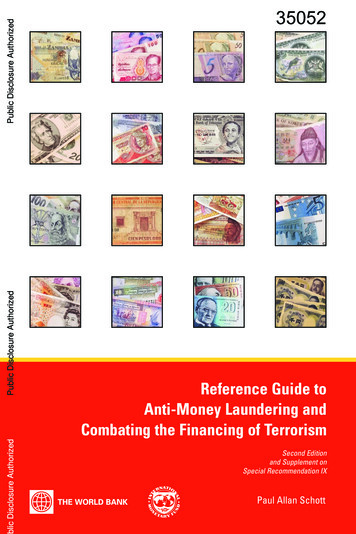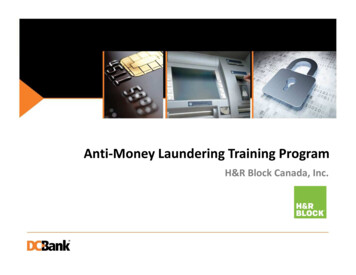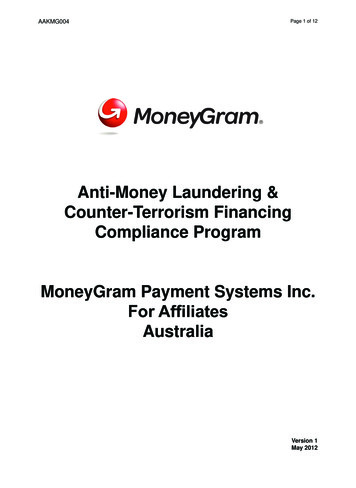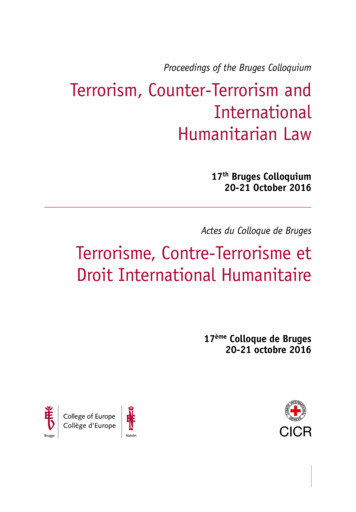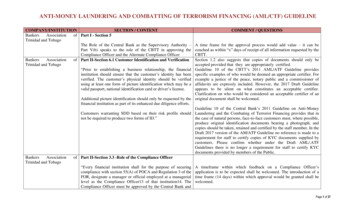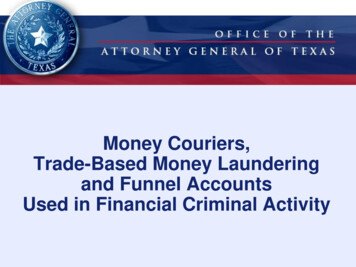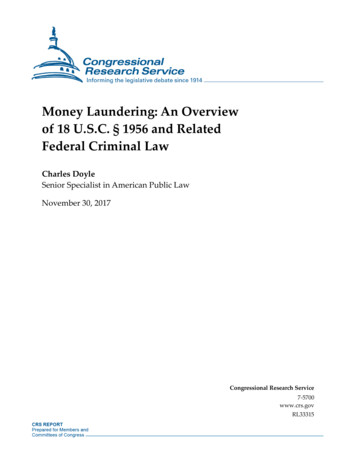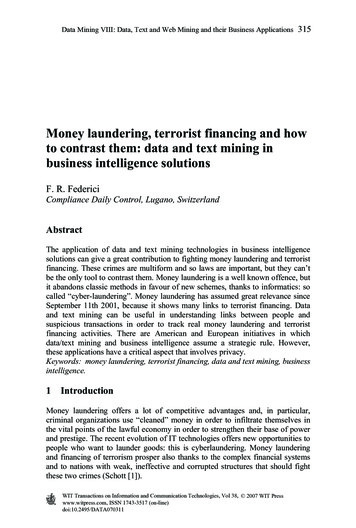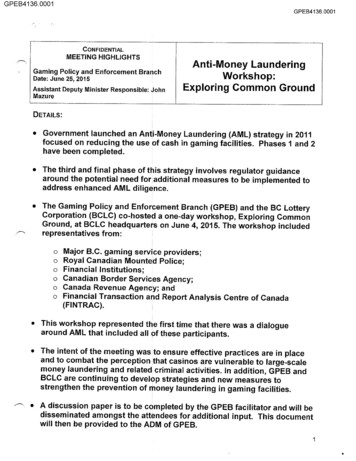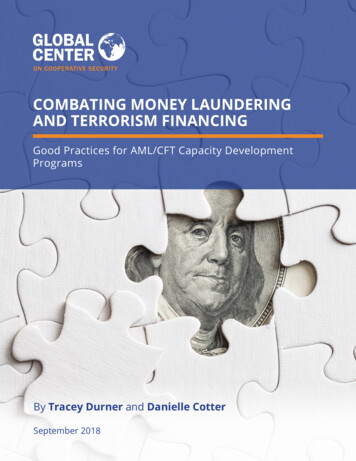
Transcription
COMBATING MONEY LAUNDERINGAND TERRORISM FINANCINGGood Practices for AML/CFT Capacity DevelopmentProgramsBy Tracey Durner and Danielle CotterSeptember 2018
Copyright 2018 Global Center on Cooperative SecurityAll rights reserved.For permission requests, write to the publisher at:1101 14th Street NW, Suite 900Washington, DC 20005USADESIGN: Studio You LondonSUGGESTED CITATION: Tracey Durner and Danielle Cotter,“Combating Money Laundering and Terrorism Financing: GoodPractices for AML/CFT Capacity Development Programs,” GlobalCenter on Cooperative Security, September 2018.globalcenter.org
COMBATING MONEY LAUNDERINGAND TERRORISM FINANCINGGood Practices for AML/CFT Capacity Development ProgramsBy Tracey Durner and Danielle CotterSEPTEMBER 2018
ABOUT THE AUTHORSTRACEY DURNERTracey Durner is a Senior Analyst for the Global Center onCooperative Security. She specializes in financial inclusion issues,including anti–money laundering and countering the financingof terrorism (AML/CFT) and bank de-risking. Focusing on theGreater Horn of Africa region in particular, she has coauthoredand contributed to reports on countering violent extremism andAML/CFT topics and assisted in the design and implementation ofregional capacity-building programs. She holds a BA in internationalaffairs and political science from Northeastern University.DANIELLE COTTERDanielle Cotter is a Senior Analyst for the Global Center. She focuseson research and programming related to anti–money launderingand countering the financing of terrorism (AML/CFT), particularlyin the Greater Horn of Africa and the Middle East and North Africaregions. She has contributed analysis to reports on AML/CFT issuesand countering violent extremism and works on capacity-buildingprograms with a focus on developing economies. She holds a BA ininternational relations with an East Asia focus from Tufts University.ACKNOWLEDGMENTSThe Global Center gratefully acknowledges the support for thisreport provided by the government of Norway. The authorsrecognize the contributions of Todd Harland, Gavin Durbin, andMatthew Schwartz and the guidance of Alistair Millar, Liat Shetret,Eelco Kessels, and Jason Ipe.The views expressed are those of the authors and do not necessarilyreflect the views of the Global Center or its advisory council or thegovernment of Norway.
TABLE OF CONTENTSAbbreviationsivIntroduction1AML/CFT Landscape3Emphasizing Effectiveness Over Technical Compliance3Convergence and Divergence of Responses to MoneyLaundering and Terrorism Financing4Ensuring ‘Do No Harm’ Principles6Prioritizing Financial Inclusion7Considerations for AML/CFT Programming9Inception and Program Design10Program Implementation14Monitoring and Evaluation20Policies, Priorities, and Practice25Box 1. Enhanced Ability to Detect and Investigate Financial Crime23
ABBREVIATIONSAMLanti–money launderingCFTcountering the financing of terrorismCIFGCounter ISIL Finance GroupFATFFinancial Action Task ForceFDIforeign direct investmentFinCENFinancial Crimes Enforcement Network (U.S.)FIUfinancial intelligence unitFSRBFATF-style regional bodyGFIGlobal Financial IntegrityIFFillicit financial flowIMFInternational Monetary FundISILIslamic State of Iraq and the LevantMLAmutual legal assistanceMOUmemorandum of understandingODAofficial development assistanceOECDOrganisation for Economic Co-operation and DevelopmentSTRsuspicious transaction reportUNUnited NationsU.S.United StatesCombating Money Laundering and Terrorism Financing iv
INTRODUCTIONMoney laundering, terrorism financing, and otherillicit financial flows (IFFs)1 present significant challenges to security and development, underpinningtransnational crime and terrorism networks. IFFs hinder economic development by draining capital fromdeveloping countries and reducing the amount of taxrevenue and other resources available for governmentsto invest in infrastructure and socioeconomic services.This contributes to conditions of relative deprivationand marginalization that drive conflict and violentextremism. Widespread corruption, poor governance, and weak financial oversight further constraineconomic growth and contribute to enabling environments for violent extremism.This report seeks to merge the rich body ofgood practices for implementing AML/CFTstandards with the foundation of literatureon approaches to capacity development.An accurate measurement of the scale of IFFs is difficult. Because the funds are illicit, they are oftenconcealed, whether through unrecorded trade flows,false or misinvoicing practices, or transactions outside of the formal financial sector. The estimates thatdo exist are staggering. In 2012 the total value ofIFFs from 145 developing countries was estimated tohave been greater than the combined total of foreigndirect investment (FDI) and net official developmentassistance (ODA) received by those countries.2 Asdeveloping countries experience rapid economicgrowth, regional and international integration, and123456increasingly liberalized markets, the IFF total is rising.Between 2003 and 2012, IFFs from developing countries grew at an estimated annual rate nearly doublethat of gross domestic product, totaling an estimated 6.6 trillion.3 The most recent figures show an estimated 1 trillion in illicit financial outflows in 2014alone.4 More than half of IFFs are estimated to end upin developed countries and a further 45 percent in offshore financial centers.5As such, combating IFFs by empowering institutions with mandates on anti–money laundering andcountering the financing of terrorism (AML/CFT)has emerged as a critical element of comprehensiveapproaches to security and development. Beyondcurbing illicit finance, AML/CFT activities can supportefforts to address corruption, weak governance, andfinancial exclusion, helping to prevent and counterviolent extremism. Recognizing that the financial system is only as secure as its weakest link, a multitudeof actors, such as the World Bank, the InternationalMonetary Fund (IMF), the Egmont Group of Financial Intelligence Units, and various UN agencies, aresupporting developed and developing economies inestablishing and implementing effective AML/CFTmeasures. Bilateral engagements between countriesand institutions provide support mechanisms as well.The AML/CFT field of practice remains highly technical and complex, involving overlapping regulatorystructures, shifting and sometimes ambiguous compliance standards, and a wide and diverse range ofstakeholders. Currently, AML/CFT practitioners haveat their disposal a rich body of good practices on theimplementation of AML/CFT approaches and standards,6 as well as a foundation of literature on generalIn line with the definition used by the World Bank and Global Financial Integrity (GFI), the term “illicit financial flows” refers to the cross-bordermovement of money illegally earned, transferred, or used.Dev Kar and Joseph Spanjers, “Illicit Financial Flows From Developing Countries: 2003–2012,” GFI, December 2014, es-2003-2012/.Ibid.Joseph Spanjers and Matthew Salomon, “Illicit Financial Flows to and From Developing Countries: 2005–2014,” GFI, April 2017, /.GFI, “Illicit Financial Flows,” n.d., -flows/ (accessed 14 May 2018).For example, see IMF and World Bank, Financial Intelligence Units: An Overview, 23 July 2004, aul Allan Schott, “Reference Guide to Anti-Money Laundering and Combating the Financing of Terrorism: Second Edition and Supplement onSpecial Recommendation IX,” World Bank and IMF, 2006, s/396511-1146581427871/Reference Guide AMLCFT 2ndSupplement.pdf.Combating Money Laundering and Terrorism Financing 1
approaches to capacity development.7 This report seeksto merge the two, providing guidance on the designand implementation of effective AML/CFT-focusedprograms. The concepts discussed are relevant forAML/CFT practitioners, but the primary audience ofthis guide are those seeking to support those actors:technical assistance providers, donors, and AML/CFTpolicymakers.Drawing on the Global Center on Cooperative Security’s expertise of more than 10 years, the first sectionreflects on the current AML/CFT landscape and itsimplications for capacity development programming. Itbegins by highlighting the need to support effective systems and strengthen institutional capacities, as underscored by recent changes to international AML/CFTevaluation methodologies. It discusses the convergenceand divergence of responses to money laundering andterrorism financing, as well as some of the negative consequences resulting from AML/CFT measures and theirimplications for “do no harm” interventions. Finally, itdiscusses integrating financial inclusion elements intoAML/CFT programming to support broader economicdevelopment and security goals.Against this background, the second section outlinesgood practices for the development of regional andnational AML/CFT capacity development programs.It has segments on each stage of the program cycle:inception and design, implementation, and monitoringand evaluation. The report concludes with reflectionson how technical assistance providers can help reconcile international standards, existing policies, andpractical implementation contexts.78Building capacity is a process wherebyactors, organizations, and societies worktogether to develop, strengthen, andmaintain the skills to achieve sharedobjectives over time.In this report, the term “technical assistance provider”refers to a category of actors that support and assist“local partners,” referring to institutions that have anAML/CFT mandate, to deepen their capacities. Theuse of these terms is intended to differentiate betweenthese types of actors and does not imply a defined orstatic relationship between them. The use of “technicalassistance provider” should not limit the approaches toprogramming discussed in this report. Technical assistance suggests a one-way sharing of expertise and, asnoted by the Organisation for Economic Co-operationand Development (OECD),8 does not necessarilytranslate into capacity development. Building capacityis a process whereby actors, organizations, and societies work together to develop, strengthen, and maintain the skills to achieve shared objectives over time.This report intentionally focuses on capacity development programming, referring to collaborative, locallyowned programs that are intended to have long-term,sustained impacts on behaviors that in turn translateinto institutional and macrolevel change.For a comprehensive review on the topic, see Ian Christoplos, Kristoffer Engstrand, and Anna Liljelund Hedqvi, “Capacity Development LiteratureReview,” UTV Working Paper, no. 2014:1 (April 2014), eview 3761.pdf.OECD, “The Challenge of Capacity Development: Working Towards Good Practice,” DAC Guidelines and Reference Series, 2006, lding/pdf/DAC paper final.pdf.Combating Money Laundering and Terrorism Financing 2
AML/CFT LANDSCAPEAlthough efforts to address financial crimes have beendeveloped and deployed for many decades, the globalfocus on AML grew out of international efforts tocrack down on drug smuggling in the late 1980s. TheFinancial Action Task Force (FATF) was established in1989 as an intergovernmental body focused on combating money laundering. Following the 11 September2001 terrorist attacks in the United States, these effortswere expanded to include terrorism financing. Today,the FATF Recommendations and related guidancedocuments represent the international standards onAML/CFT.9 FATF and associated regional bodies regularly conduct and publish a desk-based and on-siteassessment of a country’s compliance with the recommendations. The United States has also been a drivingforce on AML/CFT issues globally, including by application of sanctions and extension of the extraterritorial reach of its national AML/CFT laws through thePATRIOT Act and other measures.10 More recently, theEuropean Union issued its fourth AML directive—themost sweeping AML/CFT legislative act in Europe inyears—which has implications for financial sectorsseeking to engage with European markets.11The evolving and overlapping nature of these legalframeworks has created a complex web that can bechallenging for countries to navigate and effectivelyimplement. In some instances, the shifting compliancelandscape has resulted in frustration for emergingAML/CFT regimes that have met the standards onlyto see the bar raised higher or new standards issued.Many simply cannot match the rapid pace of change.Below are key aspects of the evolving AML/CFTlandscape relevant for technical assistance providers,including recommendations for adapting and reflecting these contexts in AML/CFT capacity developmentprograms.EMPHASIZING EFFECTIVENESSOVER TECHNICAL COMPLIANCEAs the most widely recognized international standard-setting body on AML/CFT matters, FATF drivespolicy discourse and practitioner implementationefforts. Although not legally binding, compliance withthe FATF Recommendations is commonly seen ascritical for jurisdictions seeking to retain access to theglobal financial system. FATF’s enforcement powercomes from its publication of triannual lists of highrisk and noncooperative jurisdictions. Colloquiallyreferenced as a unified “Public Statement,” it includestwo lists: one with countries that are high risk andnoncooperative, and another with monitored jurisdictions that have “strategic AML/CFT deficiencies”and are working with FATF to address them.12 Comparatively evaluating jurisdictional risk solely basedon compliance with the FATF Recommendations canbe problematic. Incomplete or ineffective regulationis a concern, but the scale and volume of transactionsmust also be considered. Large financial hubs such asthe United States and United Kingdom may presentcomparatively equal or higher money laundering orterrorism financing risks due to their centrality in theinternational financial system, yet their robust compliance regimes mean they are unlikely to be included inthe Public Statement.Inclusion on an FATF list comes with consequences.FATF calls on its members, which include the largestglobal economies, and other jurisdictions to applyadministrative and financial measures against countries identified as high risk, making it difficult andexpensive for members to conduct business with listedcountries. The monitored jurisdiction label suggeststhat a country’s financial institutions are considered toFATF, International Standards on Combating Money Laundering and Financing of Terrorism and Proliferation: The FATF Recommendations,February 2012, mmendations/pdfs/FATF Recommendations.pdf.10 For further discussion, see Robert J. Graves and Indranil Ganguli, “Extraterritorial Application of the USA PATRIOT Act and Related Regimes: Issuesfor European Banks Operating in the United States,” Privacy and Data Security Law Journal, October 2007, pp. 967–1003, bef3c83a-6b61-46f4-9229-48c2369e9628/Graves Ganguli.pdf.11 “Directive (EU) 2015/849 of the European Parliament and of the Council of 20 May 2015 on the Prevention of the Use of the Financial System for thePurposes of Money Laundering or Terrorist Financing, Amending Regulation (EU) No. 648/2012 of the European Parliament and of the Council, andRepealing Directive 2005/60/EC of the European Parliament and of the Council and Commission Directive 2006/70/EC,” 2015 O.J. (L 141) 73.12 Inclusion in either part of the Public Statement is based on review by the FATF International Coordination and Review Group. For more information,see FATF, “High-Risk and Other Monitored Jurisdictions,” n.d., http://www.fatf-gafi.org/countries/#high-risk (accessed 15 May 2018).9Combating Money Laundering and Terrorism Financing 3
be at risk for money laundering and terrorism financing exploitation. This may dissuade foreign countries,investors, and financial institutions from engagingwith the listed jurisdiction, resulting in reducedinvestment and hindering economic development.For emerging economies seeking to attract and retainFDI and integrate into global financial markets, thiscan be a significant blow. The Public Statement hasproven a successful motivator: of the 65 countries thathave been publicly identified by FATF since November 2007, 53 have demonstrated progress sufficient forremoval from the process.13For more than a decade, FATF focused on technical compliance, assessing whether a country has thenecessary frameworks and institutions in place. As aresult, countries and technical assistance providersprioritized enacting and strengthening laws and establishing or operationalizing financial intelligence units(FIUs) as the key national body responsible for receiving, analyzing, and disseminating suspicious transaction reports (STRs) and other relevant AML/CFTinformation. Emphasis on technical compliance oftenresulted in countries and technical assistance providerstaking a tick-box approach to AML/CFT concerns thatdid not necessarily lead to an increase in the effectiveness and capacity of systems and institutions. Toaddress this, FATF revised its mutual evaluation criteria in 2012 to include 11 Immediate Outcomes thatassess how well AML/CFT systems are working.14This “effectiveness of implementation” standard issignificantly higher and more difficult to demonstratethan technical compliance, and it will take time forcountries to become compliant. To date, only five ofthe 48 countries evaluated under the revised criteriahave been found to have high effectiveness, and onlythe United States has been rated as highly effective onmore than one indicator.15 A lack of clarity exists surrounding how effectiveness is measured. At present,assessors appear to be giving weight to the numberof investigations, prosecutions, and convictions forThis shift in the FATF assessmentmethodology underlines the need fortechnical assistance providers to prioritizeoperational effectiveness and institutionalcapacity development.money laundering and terrorism financing. Yet, manycountries have lengthy judicial backlogs that couldhinder their ability to demonstrate effectiveness withinevaluation timelines. Further, it is ultimately a reactive metric that does not account for the strength andeffectiveness of a country’s preventative measures.This shift in the FATF assessment methodology underlines the need for technical assistance providers toprioritize operational effectiveness and institutionalcapacity development. Although a role for technicaltrainings remains, capacity development also demandsinterventions focused on practitioner-level outputsand institutional outcomes that promote sustainedimplementation in practice.CONVERGENCE AND DIVERGENCEOF RESPONSES TO MONEYLAUNDERING AND TERRORISMFINANCINGFollowing the 11 September attacks, FATF issued aspecial set of recommendations specific to terrorismfinancing. In 2012, these were consolidated into theFATF Recommendations and have been subsequentlyrevised on a regular basis, in line with a trend amongthe international community toward viewing AMLand CFT as a unified field of practice. Money laundering and terrorism financing often exploit the samevulnerabilities in the financial system, and similar13 FATF, “High-Risk and Non-Cooperative Jurisdictions,” n.d., non-cooperativejurisdictions/?hf 10&b 0&s desc(fatf releasedate) (accessed 19 May 2018).14 FATF, “Methodology for Assessing Technical Compliance With the FATF Recommendations and the Effectiveness of AML/CFT Systems,” February2018, 5 FATF, “Table of Ratings for Assessment Conducted Against the FATF Recommendations, Using the 2013 FATF Methodology,” 18 May 2018, Round-Ratings.pdf.Combating Money Laundering and Terrorism Financing 4
processes and institutions are tasked with identifying,tracking, and combating these crimes.organizations remain some of the key terrorismfinancing typologies used by violent extremist groups.Yet, the needs and motivations of money launderersand terrorism financiers often differ. Money laundering always involves a predicate offense that generatesthe funds or assets to be laundered. Money launderers are seeking to integrate “dirty money” into thefinancial system to make it appear legitimate. Theyare often looking to conceal large amounts of fundsor assets and typically utilize multiple transactionsconducted through various mediums to distance theproceeds from the original crime. In terrorism financing, the source of the funds is not exclusively illegal.16Terrorism financing can have legitimate sources, forexample an individual who donates a portion of theirlawful income, either knowingly or unknowingly, to aterrorist group. As such, terrorism financiers may uselaundering techniques not to conceal the source of thefunds, but rather to conceal its support for terroristacts or groups. The continuing proliferation of lowcost and high-impact terrorist activity demonstratesthe relatively small amount of funding required for anattack, thus rendering it easier to transmit and moredifficult to detect. Consequently, different sectors ormethods may be more appealing or viable for terrorism financiers to exploit than those simply seeking toconceal origins of funds.In response to these trends and reflecting the growingbody of knowledge on CFT, the international community is increasingly treating AML and CFT as separatefields of policy and practice. FATF issued revised guidance on emerging terrorism financing risks in 201517and set out a consolidated strategy on combating terrorism financing in 2016.18 New international bodieswith a CFT-specific remit have emerged, including theGlobal Coalition to Counter ISIL and its Counter ISILFinance Group (CIFG). In turn, AML efforts are morefrequently included within broader counter-IFF, anticorruption, or asset recovery initiatives and framed aspart of broader development and governance initiatives.The rise of the Islamic State of Iraq and the Levant(ISIL) and its effectiveness at self-financing hasrenewed international attention on the specific waysthat terrorists and their sympathizers fund their actsand operations. These include raising funds via controlled territory (e.g., taxation, natural resource extraction, and extortion), utilizing social media platformsto solicit donations, accessing new payment servicessuch as prepaid cards, and recruiting foreign terroristfighters to provide material support and resources.Extortion, kidnapping for ransom, abuse of legitimatecommercial enterprise, and the abuse of nonprofitIn response to these trends and reflectingthe growing body of knowledge on CFT,the international community is increasinglytreating AML and CFT as separate fields ofpolicy and practice.For technical assistance providers, this redivergencebetween AML and CFT is reflected in the OECD guidelines regarding ODA classification. AML capacity development programs with the main objective to counterIFFs are eligible for ODA funding under the rubric of“promoting the economic development and welfareof developing countries.”19 Expressly antiterrorismactivities, which can include engagement on CFT withrelevant agencies and institutions that have counterterrorism mandates, are excluded from ODA eligibility. Asa result, a number of donors have designed CFT-specificinterventions that are not ODA eligible and that engagemore traditional counterterrorism partners.16 See Erik Alda and Joseph L. Sala, “Links Between Terrorism, Organized Crime, and Crime: The Case of the Sahel Region,” Stability: InternationalJournal of Security and Development 3, no. 1 (2014).17 FATF, Emerging Terrorist Financing Risks, October 2015, rts/Emerging-Terrorist-Financing-Risks.pdf.18 FATF, “Consolidated FATF Strategy on Combatting Terrorist Financing,” 19 February 2016, rts/FATF-Terrorist-Financing-Strategy.pdf.19 OECD, “Official Development Assistance—Definition and Coverage,” n.d., ssistancedefinitionandcoverage.htm (accessed 19 May 2018).Combating Money Laundering and Terrorism Financing 5
Technical assistance providers should be mindful ofthese considerations when exploring programmingoptions. Securing a mix of ODA and non-ODA funding may be required to engage with the full spectrumof CFT-relevant agencies, which includes intelligenceand counterterrorism-specific civilian or militaryunits.20 Further, donors and providers must work toensure alignment and complementarity between programs on AML and CFT. Each of the different AML/CFT actors has a unique role to play in combatingIFFs. Critically, demonstrating effectiveness of implementation will require proficient coordination andcollaboration between governmental actors (FIUs,law enforcement, judiciary, and intelligence bodies)and with the private sector reporting entities, who areon the front lines of money laundering and terrorismfinancing prevention.ENSURING ‘DO NO HARM’PRINCIPLESAML/CFT activities are a necessary element of peaceand stabilization efforts, yet their implementation hasnot been without significant negative consequences.UN Security Council Resolution 1373, passed unanimously in the days after the September 11 terroristattacks, required all member states to implement lawsthat criminalized terrorism financing and to freeze theassets of individuals and entities associated with terrorism or terrorist networks. Such requirements werefurther elaborated under FATF Recommendations5 and 6. In the past, sanctions regimes applied onlyto individuals and entities designated by the UnitedNations. Without a universal definition of terrorism,Resolution 1373 allowed states to determine their owncriteria for the domestic designation of terrorists andterrorist organizations. In his 2015 report to the Secretary-General, the UN Special Rapporteur on counterterrorism and human rights noted that “many of themeasures taken or envisaged by States violate the principle of legality by containing overly broad and vaguedefinitions of terrorism. Unclear, imprecise or overlybroad definitions can be used to target civil society,silence human rights defenders, bloggers and journalists, and criminalize peaceful activities in defence ofminority, religious, labour and political rights.”21Although revised in 2016, FATF Recommendation 8previously identified nonprofit organizations as “particularly vulnerable” to terrorism financing due to thebelief that terrorists were exploiting civil society organizations to raise and transfer funds, support recruitment, and provide logistical support. This terminologycreated significant reputational challenges for nonprofit organizations and has resulted in heightenedscrutiny and administrative burdens, such as new orexpanded licensing and registration requirements andlimitations or bans on foreign funding. Such measuresallow governments wide discretion and influence overthe establishment and operations of civil society22 andcan be abused to further target political dissidents andconstrain freedoms of speech and association.Another unintended consequence that has gainedprominence in recent years is de-risking, or the closure of accounts, transaction delays, and denial of services to categories of clients. Heavily impacted sectorsinclude correspondent banking relationships, moneyservice businesses, and nonprofit and humanitarianorganizations, especially those operating in conflict ordisaster-affected areas.23 The term “de-risking” itself isproblematic, suggesting that the financial institutionsare acting solely on the basis of risk when the driv-20 Alistair Millar, “Updated Guidance on ODA-Eligible Activities for Preventing Violent Extremism: Implications and Opportunities for the EuropeanUnion,” Counter-Terrorism Monitoring, Reporting and Support Mechanism, n.d., 7/05/DAC-and-PCVE-Think-Piece-1.pdf.21 UN General Assembly, “Promotion and Protection of Human Rights and Fundamental Freedoms While Countering Terrorism: Note by theSecretary-General,” A/70/371, 18 September 2015, para. 14.22 Ben Hayes, “The Impact of International Counter-Terrorism on Civil Society Organizations: Understanding the Role of the Financial Action TaskForce,” Brot für die Welt, April 2017, p. 21.23 World Bank, Report on the G20 Survey on De-Risking Activities in the Remittance Market, October 2015, es-De-risking-Report-2015-Final-2.pdf; World Bank, Withdrawal FromCorrespondent Banking: Where, Why, and What to Do About It, November 2015, vember-2015.pdf; Sue E. Eckert, Kay Guinane, and Andrea Hall, “Financial Access for U.S. Nonprofits,”Charity and Security Network, February 2017, nancialAccessFullReport 2.21%20(2).pdf.Combating Money Laundering and Terrorism Financing 6
ers are actually more varied and complex. Perceivedclient risk and concern over rising AML/CFT finesand enforcement actions are an element o
affairs and political science from Northeastern University. DANIELLE COTTER Danielle Cotter is a Senior Analyst for the Global Center. She focuses on research and programming related to anti-money laundering and countering the financing of terrorism (AML/CFT), particularly in the Greater Horn of Africa and the Middle East and North Africa .
